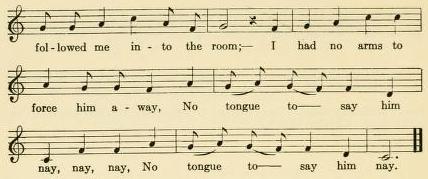Seventh King's Daughters- York (NC) 1940 Brown 4C
[From Brown Collection of NC Folklore; there are 7 versions of text A-G plus additional versions with music in Vol. 4. It's hard to understand the role of the Yorks (Mr. and Mrs. James York) in the Brown Collection; they were singers and arrangers of traditional music but were they also informants. This version may not be traditional but it is not found elsewhere in the Brown Collection. There's a recording in the Abrams Collection that includes the second verse.
See also York's text from James Madison Carpenter Collection, JMC/1/7/1/C, p. 10673, with slight differences, at the bottom of the page.
R. Matteson 2014, 2018]
OLDER BALLADS MOSTLY BRITISH
Lady Isabel and the Elf-Knight (Child 4)
For the history of this ballad in many lands and tongues, see Child's headnote in English and Scottish Popular Ballads and Grundtvig's in Danmarks gamle Folkeviser, and for its occurrence since Child's time in the British Isles and in America, see BSM 5-6 — and add to the references there given Arkansas (OFS I 47), Florida (FSF 237-41), and Missouri (OFS I 45-6). It is a favorite among the ballad singers of North Carolina; Mrs. Sutton reports that it was sung by Mrs. Hall in Buncombe county, by Mrs. Gordon in Henderson county, by Mrs. Brown in Avery county, and others. Mrs. Steely records three texts, with tunes, found in the Ebenezer community in Wake county. The name of the heroine varies. Most often it is Polly. The names Clovanne (in version C) and Cold Rain (in version D) may be assumed to derive from the May Colvin of British broadside versions. The villain, if named at all — as generally he is not in the North Carolina versions — is William. All three of the scenes that make up the story, the elopement, the drowning, the dialogue with the parrot, are present in all the North Carolina versions, even the much reduced F. Versions D, E, and G show the shift of grammatical person from the first person to the third which is so frequent in traditional balladry.
C. 'The Seventh King's Daughters.' Sung by Mrs. James York. Recorded by Dr. W. A. Abrams at Olin, Iredell county, 1940, from original at Boone, August 8, 1940. This tune very closely resembles Mrs. Myra Barnett Miller's tune for 'Pretty Polly' (2A) and has the same approach to the final.


For melodic relationship, cf. ***SharpK i 5-12, No. 3 A, B, D, E, G;
FSS 521, No. iB; **FSF 268, No. 157B ; OFS i 67, No. 6A ('Edward'); *OFS I 41, No. 2A; SCSM 400, A, first four measures; OFS i 48, No. 3, the first eight measures there are like the first four in our version; PSL 30, measures 3-4; TBV 550, No. 3D; FSOA 54.
Scale: Mode III, plagal. Tonal Center: f. Structure: aa1acc1 (2,2,2,2,2) = aai (4,6) ; a1 is terminally incremented. Circular Tune (V).
1. He followed me up, he followed me down,
He followed me into the room.
I had no arms for to force him away,
No tongue to say him nay, nay, nay
No tongue to say him nay.
2. So bring me some of your father's gold,
And some of your mother's fee,
And I will take it to Scotland,
And there I'll marry thee, thee, thee,
And there I'll marry thee.
________________________________
James Madison Carpenter Collection, JMC/1/7/1/C, p. 10673
[no date but around 1940]
Title: False Sir John
Lady Isabel and the Elf Knight
1. He followed me up, he followed me down,
He followed me into the room.
I had no power for to speak one word,
No tongue to answer nay, nay, nay
No tongue to answer nay.
2. So bring me some of your father's gold,
And some of your mother's fee,
And I will take you to Scotland,
And there I'll marry thee, thee, thee,
And there I'll marry thee.